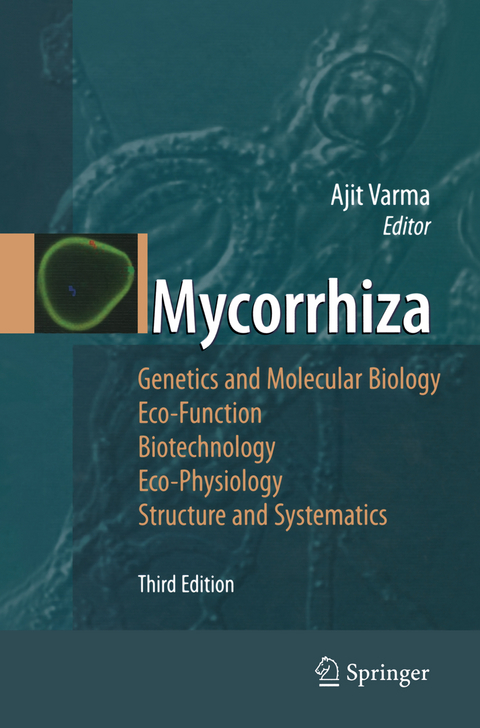
Mycorrhiza
Springer Berlin (Verlag)
978-3-662-49584-1 (ISBN)
lt;p>This third updated and revised edition emphasises strongly on genetics and molecular biology. It contains new chapters, which are written by the leading experts in their respective field of knowledge and expertise.
Mycorrhizas are symbioses between fungi and the roots of higher plants. As more than 90% of all known species of plants have the potential to form mycorrhizal associations, the productivity and species composition and the diversity of natural ecosystems are frequently dependent upon the presence and activity of mycorrhizas. The biotechnological application of mycorrhizas is expected to promote the production of food while maintaining ecologically and economically sustainable production systems.
lt;br />Ajit Varma is also series editor of our series "Soil Biology".
State of the Art. Mycorrhizal Fungi: What we Know and What should we Know? Diversity, Function and Potential Applications of the Root-Associated Endophytes. Structure, Extension and Functional Significance of Belowground Arbuscular Mycorrhizal Networks. Foraging for Resources in Arbuscular Mycorrhizal Fungi: What is an Obligate Symbiont Searching for and How is it Done? Global Diversity Patterns of Arbuscular Mycorrhizal Fungi-Community Composition and Links with Functionality. Mycorrhiza Helper Bacteria.- Genetics and Molecular Biology. Genomic Organization and Mechanisms of Inheritance in Arbuscular Mycorrhizal Fungi: Contrasting the Evidence and Implications of Current Theories. Ectomycorrhiza and Water Transport. Hypogeous Pezizaceae: Physiology and Molecular Genetics. Evaluation of the Possible Participation of Drought-Induced Genes in the Enhanced Tolerance of Arbuscular Mycorrhizal Plants to Water Deficit.- Eco-Function. The Beneficial Effect of Mycorrhizae on N Utilisation by the Host-Plant: Myth or Reality? Ion Dynamics During The Polarized Growth of Arbuscular Mycorrhizal Fungi: from Presymbiosis to Symbiosis. Arbuscular Mycorrhiza in Metal Hyper-Accumulating Plants. Mycorrhizal Fungi and Other Root Endophytes as Biocontrol Agents Against Root Pathogens. The Biocontrol Effect of Mycorrhization on Soil-Borne Fungal Pathogens and the Autoregulation of the AM Symbiosis: One Mechanism, Two Effects? Resource Partitioning Between Extraradical and Intraradical AM Fungal Mycelium. Ozone Stress and Ectomycorrhizal Root-Shoot Signalling.- Biotechnology. From Production to Application of Arbuscular Mycorrhizal Fungi in Agricultural Systems: Requirements and Needs. Agronomic Management of Indigenous Mycorrhizas. AM Inoculation in Tropical Agriculture: Field Results. The International Market Development for Mycorrhizal Technology . Why and How using Micropropagated Trees rather than Germinations for Controlled Synthesis of Ectomycorrhizal Associations? Biotechnologyand Cultivation of Desert Truffles. The Fungal Transmitted Viruses.- Eco-Physiology. Intertwined Existence: The Life of Plant Symbiotic Fungi in Agricultural Soils. Macroecology of Microbes-Biogeography of the Glomeromycota. Arbuscular Mycorrhiza of Endangered Plant Species: Potential Impacts on Restoration Strategies. Community Developmental Patterns and Ecological Functions of Ectomycorrhizal Fungi: Implications from Primary Succession. Colonization of Plant Roots by Pseudomonads and AM Fungi: A Dynamic Phenomenon, Affecting Plant Growth and Health. In vitro Cultures Open New Prospects for Basic Research in Arbuscular Mycorrhizas. Interactions of Piriformospora indica with Medicinal Plants. In Vivo Assessment of Plants' Vitality: Applications in Detecting and Evaluating the Impact of Mycorrhization on Host Plants.- Structure and Systematics. Edible Mycorrhizal Fungi: Identification, Life Cycle and Morphogenesis. Arbuscular Mycorrhiza in Physiological and Morphological Adaptations of Mediterranean Plants. Novel Symbiotrophic Endophytes. Frankia Nodulation, Mycorrhization and Interactions between Frankia and Mycorrhizal Fungi in Casuarina Plants.-
From the reviews of the third edition:
"The book is arranged in five parts and 36 chapters, each with an introduction, main contents and references. ... All chapters are well referenced ... and there is a good index at the back. ... should be available in all good school, community and university libraries and any research laboratories dealing with agriculture or mycorrhizal research. A good book addressing the mycorrhizal fungi." (K. D. Hyde, Fungal Diversity, Vol. 45, 2010)
| Erscheinungsdatum | 04.02.2016 |
|---|---|
| Zusatzinfo | XXXI, 797 p. 5 illus. in color. |
| Verlagsort | Berlin |
| Sprache | englisch |
| Maße | 155 x 235 mm |
| Gewicht | 1406 g |
| Themenwelt | Naturwissenschaften ► Biologie ► Botanik |
| Naturwissenschaften ► Biologie ► Mikrobiologie / Immunologie | |
| Naturwissenschaften ► Biologie ► Ökologie / Naturschutz | |
| Technik ► Umwelttechnik / Biotechnologie | |
| Weitere Fachgebiete ► Land- / Forstwirtschaft / Fischerei | |
| Schlagworte | Biology • Biomedical and Life Sciences • Biotechnology • Ecology • Forest • forestry • Fungi • Genetics • Geoecology/Natural Processes • growth • Microbial Genetics and Genomics • Microbiology • Molecular Biology • molecular genetics • Morphogenesis • Mycorrhiza • Physiology • Plant • plants • Plant sciences • Systematics |
| ISBN-10 | 3-662-49584-8 / 3662495848 |
| ISBN-13 | 978-3-662-49584-1 / 9783662495841 |
| Zustand | Neuware |
| Haben Sie eine Frage zum Produkt? |
aus dem Bereich


